Content Promotion Strategy: 23 Ways to Get Traffic
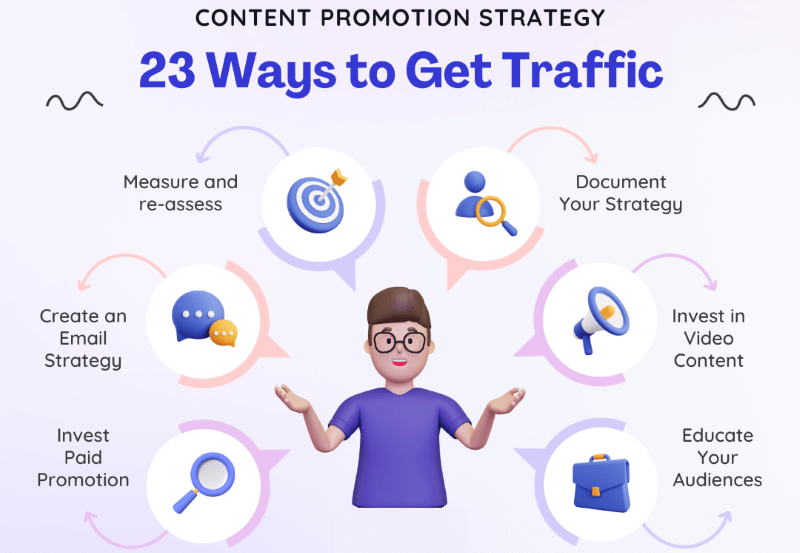
“If you write great content, people will find it.” While that’s certainly an idyllic thought of a world in which marketers can just focus on creating outstanding content, it’s just not accurate anymore.
Over 2 million blog posts are published to the web each day. Call it an era of abundance, information obesity, or the content arms race, but the truth is that it’s much harder than it used to be to build an audience.
Startup expert Neil Patel recently stated that content creation is only half the battle – the rest is gaining notice.
Due to the increasing weight of social signals in SEO rankings, social distribution can even be a precursor to gaining the search rankings you need for organic traffic. That being said, there’s a very fine line between effective content promotion and alienating your potential audience by being a spammer.
Reach Your Tipping Point
If you’re facing the challenge of building a new site’s authority and audience from the ground up, your first weeks of content promotion can feel positively pointless and frustrating. Rest assured, you will gain momentum, but it takes time and a willingness to pay your dues. Leading author Malcolm Gladwell wrote about the idea of a tipping point: “the levels at which the momentum for change become unstoppable.”
When correctly executed, your content promotion will reach a tipping point where your audience begins to do the legwork on your behalf. Visitors will share on their social channels and link to your content on their blog, you’ll become more effective at converting subscribers, and your social influence will grow:
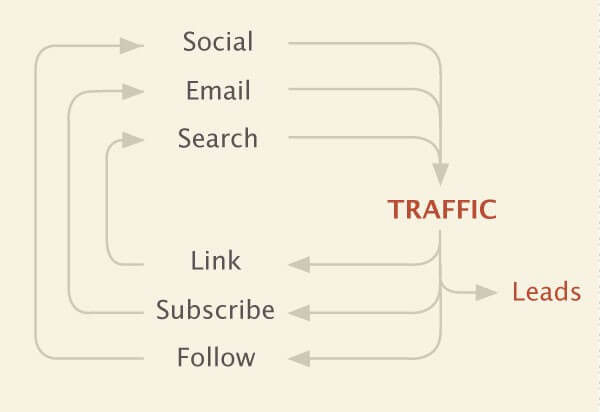
Once your blog gains momentum, you’ll become a lean machine which is able to utilize your content assets to generate social media followers, email subscribers, and high search rankings. In order to help you turn your business blog into an authoritative website, we’ve curated content promotion ideas to boost your strategy:
1. Earn Your Right to Distribute
The first step toward any content promotion strategy should be gaining the respect of your audience. Marketer Steve Weller recommends delaying the promotion of your content, to instead focus on curating really great stuff. Once you’ve built an audience who’s listening, begin sharing your own work, but avoid exceeding more than 20-30% of your own content as posts.
Inbound marketing agency Click Brands does an outstanding job of balancing their own content promotion with a high ratio of sharing other people’s work, and engagement:
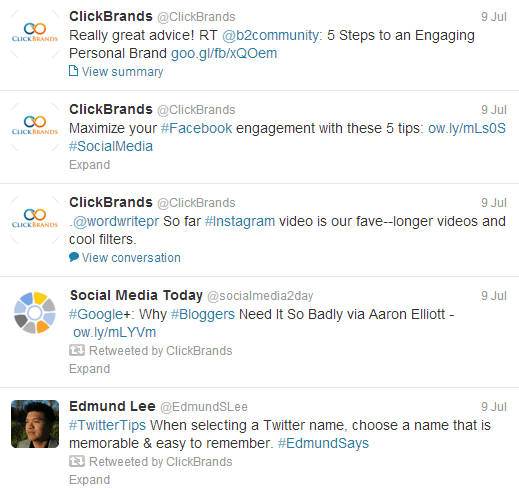
2. Post Often
Simply Tweeting a few times daily can cause your messages getting lost among other brands, while posting around the clock can alienate followers. Leo Widrich advises posting 5-10 Tweets, and 1-4 Facebook posts daily, primarily between 8am and 8pm.
While best practices indicate that the majority of engagement occurs during the day, it’s critical to do your own research on the best times for content promotion. A number of factors can affect what works optimally for your company, including the schedules and social media usage habits of your followers. Do not post more than every 1-2 hours to avoid overwhelming your followers’ feeds. Digital marketing agency Couch does a great job of spreading their Tweets out:
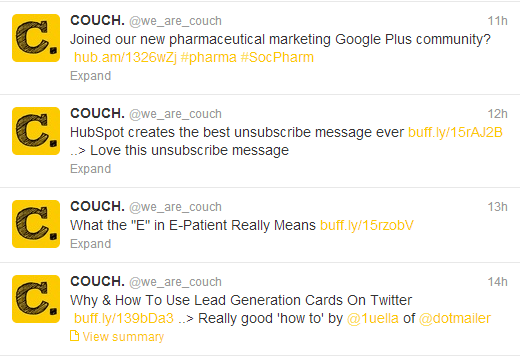
To power up your content promotion efforts, delve into our blog article on the Best Twitter Scheduling Tools.
3. Take Interesting Excerpts
Don’t solely rely on sharing titles to promote your content on social media. Matthew Gratt recommends using interesting excerpts to increase your ReTweets and shares, such as quotations and statistics. Social Media Today recently promoted an article from their network with a power stat, instead of the full title:

Stats and quotes are a powerful and effective way to earn more ReTweets because they act as a self-contained message. You’re effectively offering value to followers without even requiring them to click through, which makes them more receptive to your content promotion.
4. Post Images Separately
Upload images separately when posting content to Facebook, which has been shown to increase engagement by 46%. When sharing infographics, consider cropping a portion of the image. The anatomy of the perfect Facebook post is illustrated below:
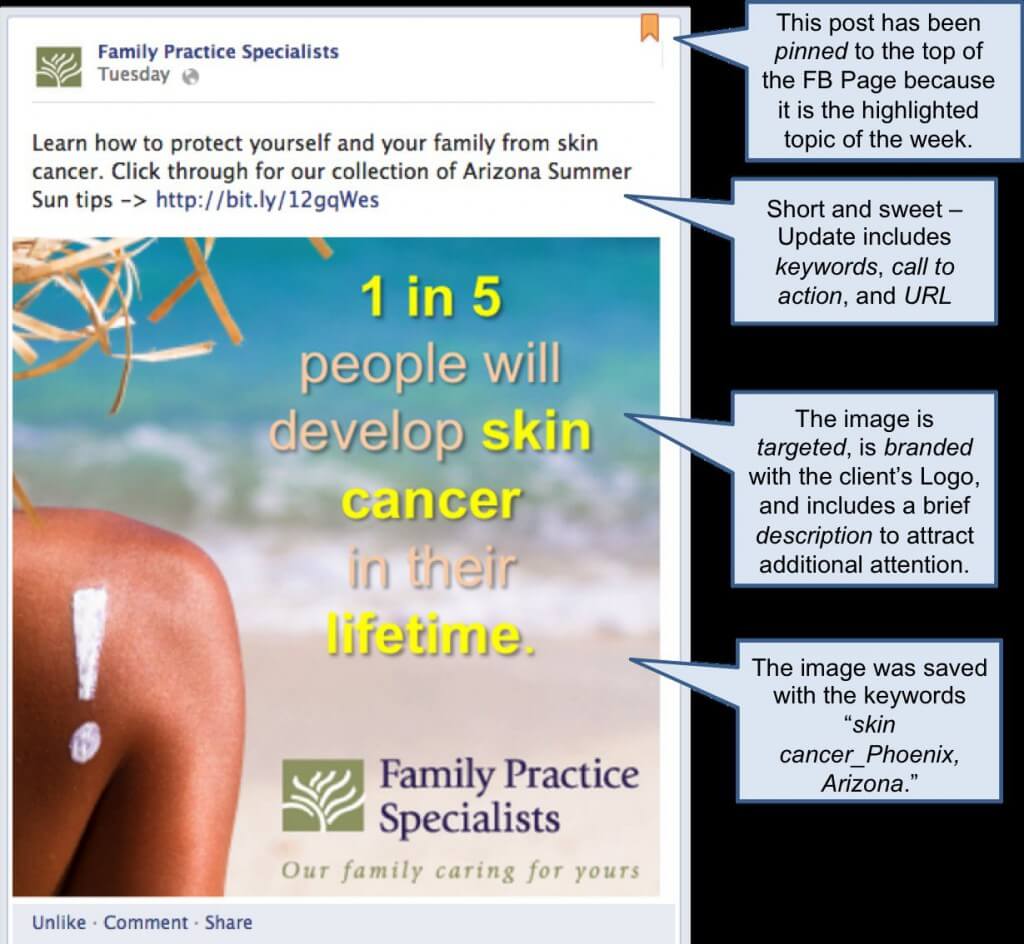
The human brain processes images 60,000 times faster than text. Targeted and eye-catching images, or pictures with text overlaid, can stand out and capture attention in a busy Facebook page.
5. Rely on Social Insights
Your content promotion strategy should rely on feedback, and adjust according to metrics. Not all data will inform, but Douglas Karr writes that the following measures can allow you to reach your tipping point:
- Keep a Close Eye on Real-Time Market Mood to Identify Content Promotion Opportunities
- Determine the Interests of Your Followers, Customers and Prospects
- Monitor Your Competition’s Social Strategy to Improve Your Own Approach
6. Have Real Dialogue
People will be more receptive to your content promotion efforts if they see you’re willing to engage with them in a way that’s a little deeper than “Thanks for the share!” Include commentary when you promote other’s content, and take the time to ask thoughtful questions on other people’s blogs. We couldn’t help but love it when content marketer Michael Campos didn’t just say “thanks!” but took the time to share his thoughts on the Writtent blog:

7. Spotlight the People Who Make Your Content Possible
If you quote someone, be sure to let them know, and provide opportunities for your readers to follow-up, too. Our blog article, Creative Marketing Ideas from 10 Great Thought Leaders, includes the Twitter handle for each amazing marketer who we spotlighted, which is shown below:
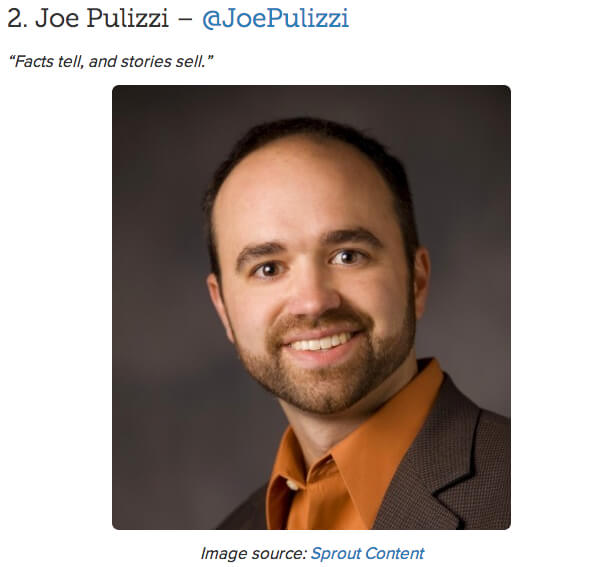
8. Try Really Niche Networks
Gentlemint, a Pinterest-style website dedicated to “manly things?” CafeMom, a community for Mothers? As social expert Rachel Sprung points out, the right niche network could remove any need to target your content promotion efforts. To find out the networks which could be a potential goldmine for content promotion, interview your current customers about their social media usage. Whether they’re using Quora or Meetup.com, start a profile and begin posting updates on the niche network.
9. Curate Thoughtfully
People love being promoted by others, which is why curation can be among the most effective forms of content promotion. Weekly news posts have become a highly-effective tool for driving traffic, generating interest, and connecting with new readers.
To begin creating your own round-up posts, keep a close eye on your RSS feeds and favorite blogs to curate the most interesting and relevant content published each week. Provide a clear link to the content and short commentary on why it’s worth the read. Be sure to notify each blog you spotlight with a Tweet or email to maximize your potential for content promotion.
10. Leverage Hashtags
When used properly, hashtags aren’t an avenue for spammy content promotion. They’re a tool to target the right people by allowing your content to be categorized. As Katie Lundin points out in crowdspring, using hashtags as a tool for joining and participating in conversations (as opposed to trying to boost the chances your links will be clicked) can be a powerful maneuver.
A recent Tweet from marketing automation specialists Kuno Creative displayed the perfect balance of readability and Twitter search optimization:

Their content promotion can gain more exposure by being primed for search by individuals looking for insights on social media or Facebook marketing. By limiting their hashtag use to two tags, and capitalizing the first letter of each word in the hashtags (a concept known as camel case), the content is still easy-to-read for followers.
11. Be Where You Need to Be
Did you know the average social media user only maintains two profiles? Or that, according to Mashable, many just stick to one? If your brand’s ideal buyer persona isn’t especially tech-savvy or interested in much besides Facebook, it may be much wiser to truly focus your efforts on the right network. Find out which network your clients prefer spending time on, and make sure your presence on that platform is as robust as possible.
12. Ask Questions
Your content promotion strategy will quickly fizzle if your fans figure out you aren’t willing to listen, but are just hoping to be heard. Dedicate posts to asking questions, in addition to sharing links. Belinda Little defined the three following types of queries:
- Pure Fan Engagement: Which sports team are you cheering for in this weekend’s big match? What New Year’s resolutions did you make or break this year? Ask about sports, career, weekend plans, or anything else to simply spark conversation.
- Market Research: Would you try a Peppermint Cappuccino? How often do you buy a new pair of shoes? Being strategic about what you ask can yield insights on your prospects.
- Company Assessment: What do you think of our website redesign? Should our next flavor be caramel or chocolate sea salt? Be direct with your prospects, and ask for their feedback about your new product, Facebook cover photo, or idea.
Starbucks sparked some serious engagement (while promoting their ice cream products) in a recent question to Facebook fans:

13. Guest Post More Often
You don’t need to land a guest post on Social Media Examiner or Eloqua to see noticeable results in SEO and referral traffic. A HubSpot case study revealed 60,000 new visitors from search within 6 months of publishing 28 quality guest posts, just by targeting medium-sized blogs.
Identify websites with a mission and audience that closely match your own, and pen a thoughtful pitch to the blog manager. Include several ideas for content that will add value to their website, and a short description of the concepts you hope to cover in each article. For more insights on how to take full advantage of this content promotion opportunity, check out our Exhaustive Guide to Exceptional Guest Blogging.
14. Write Better Titles
If you feel like you’re stuck entirely, your titles could be to blame. In an analysis of 2.7 million blog articles, HubSpot’s social media scientist Dan Zarrella found that 16.7% of webpages gain more social shares than clicks; indicating that people don’t always read what they Tweet, and great titles are critical. Using Portent’s free title generator could provide an amazing boost.
15. Integrate Sharing Opportunities
Your chances of receiving content promotion from readers may increase exponentially if you integrate sharing opportunities. Optimization Group is one of several brands who do period round-ups of “Tweetable stats” with one-click social sharing for each statistic spotlighted, which is illustrated below:

16. Buy Some Links
We’re definitely not suggesting you head to Fiverr and purchase a boatload of irrelevant links to your website, which will probably get you banned from appearing in Google search entirely. Sponsoring local sports teams, events and non-profit organizations can generate links and media attention which aren’t inherently sketchy. Feeling unsure? Rand Fishkin of SEOMoz condones the method.
17. Offer a Reward for Subscribing
Building an army of engaged subscribers can make content promotion significantly easier. Carolyn Edgecomb of Impact Branding & Design advises content marketers to offer an exclusive offer like a whitepaper or eBook to entice visitors to convert into subscribers.
Personal finance blogger Stacy Makes Cents offers a free eBook on budgeting and debt-free living in exchange for subscribing to her updates, which is clearly displayed on the sidebar of her website:
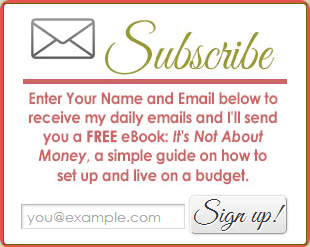
18. Build and Utilize Your Email List
Patel’s research has found that email is the single most-effective channel for getting readers to return to your website. Use your email list sparingly, and consider offering the option of a weekly blog digest to spotlight your best new developments. Other ways to promote your content via email could include:
- Sending buyers guides and competitive comparisons to prospects.
- Providing exclusive content offers to email subscribers.
- Sharing tutorials on how to get the most from your product or service with new customers.
19. Create Pinnable Images
Pinterest is too big of a social media network for almost any company to ignore. If you’re offering a tutorial, guide, or other helpful content that could thrive on the network, create images that are pin-ready by including descriptive text and a branded watermark.
Food and lifestyle blog Six Sisters Stuff perfectly enhanced a recipe post for Pinterest by including bold, easy-to-read text primed to stand out in a busy feed:
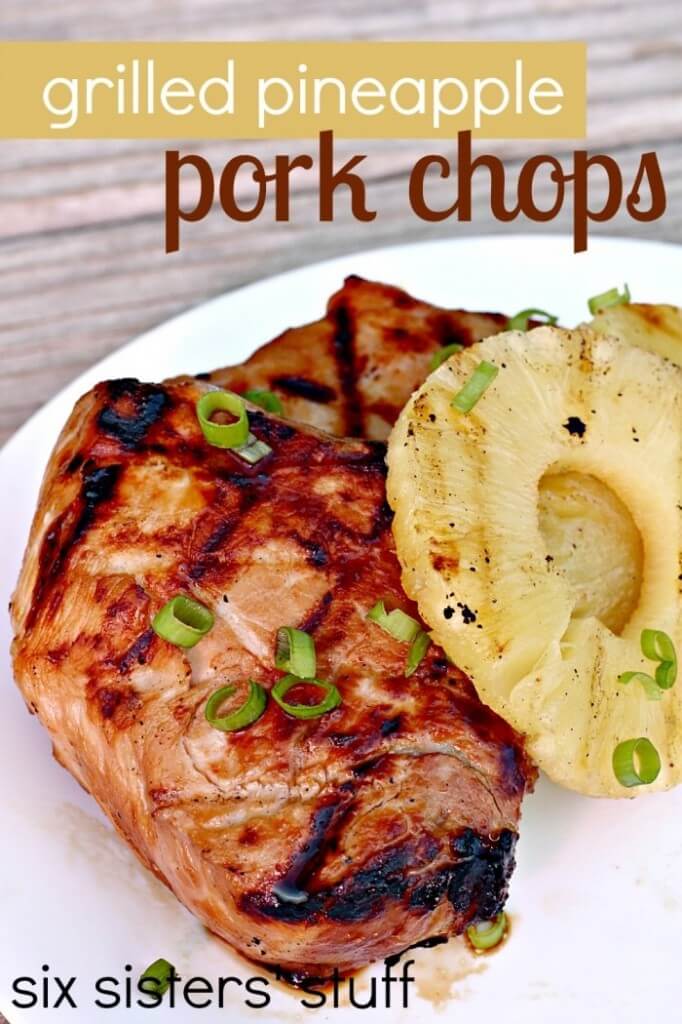
20. Don’t Ignore Reddit
It’s controversial and definitely includes content that’s not safe for work, but Reddit is an underutilized resource for content promotion. Averaging around 71 million unique visitors daily, it’s critical for marketers to become engaged on the network as opposed to just posting links, because of the role a user’s “reputation” score plays on the network. At last count, there were around 5,400 unique forums (known as “subreddits”), so pick the arenas that are the most relevant to your topic. Choose the option to “submit a new link.”

Fresh content reigns supreme on Reddit, so it’s best to limit your content promotion to highly relevant and interesting topics. Become a member of the Subreddit community and comment on other’s posts to build your reputation points.
21. Syndicate Your Content
Handing over rights for networks to republish and distribute your content can be a free, easy way to achieve some serious content promotion, as long as you’re particular about where you’re willing to syndicate. For an in-depth look at the pros and cons of syndication and networks accepting contributors, check out our article How to Triple Your Audience and Lead Generation With Content Syndication.
22. Use Communities
LinkedIn Groups and Google+ Communities can be a powerful tool for highly targeted content promotion. Keep in mind that many of these groups have strict rules against spamming or simply posting links, and focus on being a community-member, not a marketer while you’re in their space.
For both LinkedIn and Google+ group promotion, take time to find groups that best fit your niche. Join the community, and carefully read guidelines to determine any rules about content promotion. Start a new discussion by asking questions, attach the link, and invite people to participate in the discussion. In the following example from the Milwaukee HubSpot User Group, the poster outlines clear value to their group members to spark engagement:
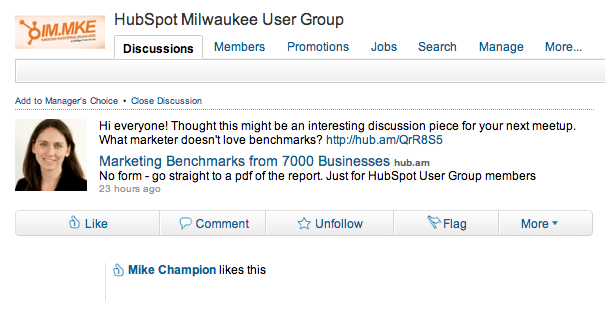
23. Subscribe to HARO.
“Help a reporter out” is a subscription-based email newsletter which connects experts with content marketers, reporters and other media opportunities seeking sources. It’s a free resource, and thoughtful pitches often yield remarkable results which can range from significant media attention to links back to your content.
How much time does your company dedicate to content promotion? Which methods have you found the most successful?

Comments (0)